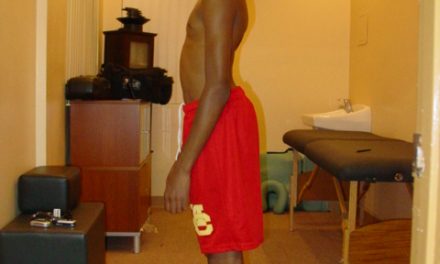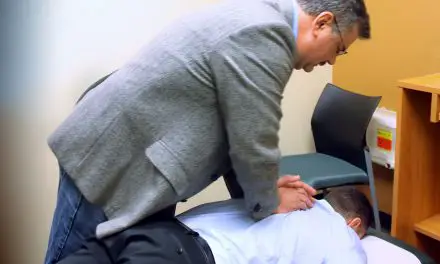Cervical lordosis refers to the natural, C-shaped curve of your neck, which is made up of seven vertebrae—C1 to C7—that work with your muscles, tendons, ligaments, and nerves to allow a wide range of movements. The curve also helps to absorb shock in the upper spine, along with the intervertebral discs between each vertebra.
While the term refers to the normal curve of your neck, cervical lordosis can also refer to having too much curve, which is often associated with forward head posture and rounded shoulders.
Some people believe that reversing cervical lordosis to make their neck appear more “normal” can reduce neck pain, but current scientific evidence finds that straightening your neck may not be necessary. That’s because neck pain is more complex than just posture alone.
Causes of cervical lordosis
First, there are several major factors that increase the risk of getting cervical lordosis:
- gender
- accidents
- disc herniation
- postural habits (e.g. looking down often)
- mental health
There’s rarely a single factor that contributes to how your neck curves. It’s often a combination of conditions that accumulates over time.
Surprisingly, some research doesn’t find aging to be a major factor of getting cervical lordosis. However, a review of more than 15,000 people with no pain found that men had more lordosis in the lower neck than women.
Is having cervical lordosis serious?
Whether you should get treated for cervical lordosis or not depends on how much pain you’re in, how much range of motion you have, and if there are any joint diseases and disabilities present.
While it’s easy to blame your posture for pain, most research since the 1960s finds little association between the way your neck curves and neck pain.
Early studies of the movement and anatomy of the cervical spine found that many people have different shapes and angles that don’t fit into the textbook description of “normal.”
- One study in 1960 found the movement pattern of the neck is a reflection of the “characteristic of that person.” This means that no “one average motion that can be ascribed to the cervical spine but rather a range of normal motions,” the author wrote.
- In the 1970s, another study found that about 20% of 360 patients with no neck pain or other symptoms had a straight or kyphotic curve in their neck when they were examined in a side-lying position. The author D.C. Weir mentioned that the loss of the cervical lordosis doesn’t mean there’s a cervical spine injury, and neck alignment is “highly variable.” This means that having a straight neck or even a slight neck hump “may be normal for the individual,” especially if they don’t have pain and can function normally.
- A 2016 study of 160 X-rays of patients with trauma to the cervical spine also found that the straightening of the cervical spine alone is not a “definitive sign of injury,” but rather it’s likely the result of how the patients were positioned when they were in a neck brace and examined in a scan.
While more studies from the 1980s to the 2000s found a poor relationship between the lack of a neck curvature and neck pain.
A 2017 review by Italian researchers found that neck posture is generally poorly associated with neck pain, disk protrusions, stenosis, spondylosis, and various neck disorders. They questioned the reliability of imaging and whether surgery is even necessary for the lack of a cervical lordosis.
“It is surely difficult to find definite answers considering that pain as a biopsychosocial phenomenon is probably too vast a problem to be simply reduced to any kind of measures, no matter how sophisticated and appealing such a computation may be,” they wrote.
In 2018, researchers in Henan, China, measured more than 15,000 asymptomatic necks from X-rays and found that 68% of them have various degrees of cervical lordosis. Among that population, they concluded that there’s “no significant relationship” between neck posture and pain or age, yet such posture was more common in men than women.
As you can see, cervical lordosis may not be as serious as some people claim. People with a straight neck or normal curves also get neck pain. And because pain is caused by multiple factors, especially chronic pain, posture may just be a small part of the problem.
However, it’s better to check with your medical professional who knows your health history to rule out common causes of neck pain.
Cervical lordosis treatments: do they work?
Many treatments have been proposed to alleviate pain and/or improve your range of motion, including exercise, massage, taping, and manual therapy.
Let’s look at how well these common treatments work.
Exercise
Some studies have shown that exercise can alleviate general neck pain.
- A 2017 systematic review from South Africa examined eight randomized controlled trials among office workers. Six of these studies found that strengthening the neck and shoulders at least one hour a week could alleviate neck pain when compared to those people who didn’t exercise. Stretching and endurance training on the neck and shoulder provide almost no additional benefit to pain relief or improve the quality of life.
- An Australian systematic review also found that strengthening exercises for the neck is effective for pain management, but the effect is “moderate” and small. The researchers also found that psychological treatments or other psychosocial factors (e.g. reassurance, education) alone also have small effects. Thus, they suggest that perhaps a combination of different treatments would be more effective than stand-alones. They also mentioned that clinicians should better understand how pain works by examining other factors that influence neck pain. These would include genetics and the immune system.
- Exercise might have a tiny effect on your neck curvature, but the evidence quality is rather poor. A 2020 joint study found that there are “some positive effects” of exercise, but most of the studies did not report how the subjects and researchers were blinded, how the trial was randomized, and other factors that gave the studies a “low” or “moderate” ranking.
In other research about other types of posture, current evidence indicates that strength training may be better for changing both kyphotic and lordotic curves.
But the amount of change for lordosis is too small to have any significance, according to a 2019 systematic review and meta-analysis.
The researchers wrote that one major drawback is that the included studies had mixed designs and different populations, which doesn’t give a consensus on how well exercise works and for whom certain exercises are for. Therefore, clinicians should not put a “one-size-fits-all” mentality to exercise recommendations for every patient.
Overall, the review recommends strength training two to three times a week for eight to twelve weeks to see any improvements of the neck.
Although there are no specific exercises that you should follow, you can still explore different exercises to see which ones work for you.
Cervical SNAGS
Deep neck flexor and extensor exercises
Neck strengthening exercises
These exercises may not change your neck posture, but they may alleviate pain and improve your neck’s range of motion. If you do have pain while doing any of these exercises, check with your doctor and/or physical therapist before continuing.
Neck adjustments
Getting your neck adjusted by a chiropractor, physical therapist, or another manual therapist might be an option, but the scant evidence isn’t clear about how well it works
A chiropractic study in 2015 found that four weeks of neck adjustments yielded no change of cervical lordosis when compared to matching healthy subjects. The researchers mentioned that their study design did not allow them to establish a cause-and-effect relationship between cervical lordosis and pain or other clinical outcomes.
Massage therapy
While there’s no scientific evidence that examines whether a neck and shoulder massage could affect the shape of the cervical spine, it may reduce pain immediately and improve neck and shoulder mobility.
But this pain relief is likely temporary, and it’s uncertain how long it lasts.
Kinesio taping
While taping isn’t likely to change the shape of your neck, it may provide short-term pain relief. One popular tape is Kinesio Tape, which has been shown to provide some pain relief for forward head posture and improve your body awareness (proprioception).
However, most research shows that it’s not any better than exercise in pain reduction or changing your posture.
Takeaway
Given the existing evidence and the complexity of pain, it’s difficult to have a straight “yes” or “no” answer to whether you should get cervical lordosis fixed.
But keep in mind that people can have neck pain, stiffness, or lack of normal range of motion whether they have a “normal” neck curvature or not.
The best way to determine whether you should correct your neck posture or not would be to consult with your physician, physical therapist, or another qualified healthcare professional. They can evaluate your health history, examine your condition, and determine the best approach to treat your specific issue.
Related stories
Why Massage Therapists Should Understand How Pain Works
Back to Basics About Psychosocial Factors in Pain
A native of San Diego for nearly 40 years, Nick Ng is an editor of Massage & Fitness Magazine, an online publication for manual therapists and the public who want to explore the science behind touch, pain, and exercise, and how to apply that in their hands-on practice or daily lives.
An alumni from San Diego State University with a B.A. in Graphic Communications, Nick also completed his massage therapy training at International Professional School of Bodywork in San Diego in 2014.
When he is not writing or reading, you would likely find him weightlifting at the gym, salsa dancing, or exploring new areas to walk and eat around Southern California.





